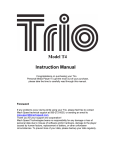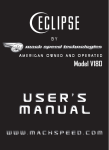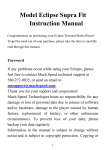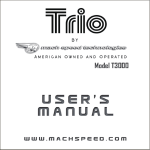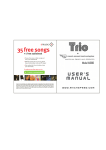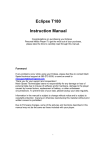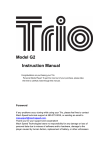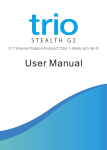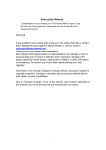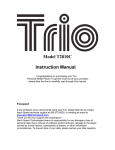Download Mach Speed Eclipse 4GB MP4 2.8" Touch Blk
Transcript
T2800 Instruction Manual Congratulations on purchasing your Trio Personal Media Player! To get the most out of your purchase, please take the time to carefully read through this manual. Foreword If any problems occur during while using your Trio, please feel free to contact Mach Speed technical support at 580-272-0035, or sending an email to [email protected]. Thank you for your support and cooperation! Mach Speed Technologies bears no responsibility for any damage or loss of personal data due to misuse of software and/or hardware, damage to the player caused by human factors, replacement of battery, or other unforeseen circumstances. To prevent loss of your data, please backup your data regularly. Information in the manual is subject to change without notice and is subject to copyright protection. Copying or otherwise reproducing this material without prior written consent is prohibited. Due to Firmware changes, some of the pictures and functions described in this manual may not be the same as are included with your player. Note: ● The playback times listed refer to the maximum playback times possible, using the best power savings. The actual playback time may differ as adjustments to screen brightness, power savings modes, volume, etc are made. ● As there are many brands of Micro SD cards in market, using different quality and speed standards. Therefore, we are unable to guarantee that our product will be compatible with all types or brands of Micro SD cards, but will be compatible with those Micro SD cards with mainstream specifications in the market, and we will constantly strive to provide the largest selection of cards possible. ● As parameters such as formats, bitrate, codecs, framerates, and resolutions differ, the player will not be compatible with all listed files. If you are experiencing issues playing your files on this player, we recommend using a supported conversion tool to reconvert your file to the specifications of the device. Caution Modifications not approved by the party responsible for compliance could void the user’s authority to operate the equipment. NOTE- This equipment has been tested and found to comply with the limits for Class B Digital device, pursuant to part 15 of the FCC rules. These limits are designed to provide reasonable protection against harmful interference in a residential installation. This equipment generate, uses and can radiate radio frequency energy and, if not installed and used in accordance with the instructions, may cause harmful interference to radio or telephone reception, which can be determined by turning the equipment off and on, the user in encouraged to try to correct the interference by one or more of the following measures: Reorient or relocate the receiving antenna. Increase the separation between the equipment and the receiver Connect the equipment to an outlet on a circuit different from that to which the receiver is connected. Consult the dealer or an experienced radio/TV technician for help. Caution • • • • • • • • • • Do not use the player in exceptionally cold or hot, dusty, damp or dry environments. Do not drop, strike, or throw your player. Physical damage to your player will void ALL warranties. Please charge your battery when Battery power icon shows an empty icon; The system automatically shuts down and the power is soon off when you switch on the unit once again; There is no response if you operate on any key Please always follow the correct disconnect procedures for your operating system. Do not disconnect power abruptly when the player is being formatted or in the process of uploading or downloading files. Otherwise it may lead to file corruption, firmware failure, and even hardware damage. We are not liable for any loss of data stored on this device. Please do not dismantle this player. Any disassembly not done by an authorized technician will void ALL warranties This product and manual are change without subject to notice. Features • • • • • • • • Touch Screen Operating system for ease of use 2.8”, 240x320 resolution, 260k color TFT touch screen Supports the following audio formats: MP3, WMA (non encrypted), OGG, APE, FLAC, and WAV Supports the following image formats: JPEG, BMP, GIF, PNG, and TIFF Supports the following Video formats: AVI (XVID), WMV (non encrypted), and FLV Supports eBook files in TXT format Built in Audio Recording software, which allows you to make voice notes in either MP3 or WAV formats Built in Micro SD card slot for expandable memory Basic Operations Powering on To power the player on, slide the power switch to the UP position and hold it there for 5 seconds or until the welcome screen is displayed. Powering off To power the player on, slide the power switch to the UP position and hold it there for 5 seconds or until the goodbye screen is displayed. Locking and Unlocking the touchscreen To lock the touchscreen, slide the power switch into the DOWN position. To unlock the touchscreen, return the power switch to the neutral or middle position. Charging the Player To charge the player, simply connect it to a powered USB port, or external AC adapter. If you choose to use a third party adapter, please ensure that it is 5V and between 350 and 500mA. When you connect the player to your computer, you will see the “USB Connected” screen displayed above. When connected to a charger, you will see the “Charging” screen. You can push the “back” button to enter the main menu and use the player while it charges. Inserting and removing the Micro SD card Inserting: Ensure that the player is powered off, and disconnected from the computer. Hold the Micro SD card face up (side with words aligned in the opposite direction of the display screen), and slide the card into the socket on the player, slightly past flush. When you hear the card click into place, you can access the card. Removing: Ensure that the player is powered off, and push the SD card just past flush. When you hear the click, release pressure, and the card will slide out. Caution: Please ensure that the power is off when you connect or disconnect your SD card, or damage may occur to the player or your card. Loading files Using Windows Media Player (Note: you must use Windows Media Player 10 or later to use this feature.) (Note: this player does not support DRM encrypted audio or video files, such as those downloaded from the Windows Media Player “Overdrive” download service.) 1. Open Windows Media Player and connect the player to a working USB port. Windows Media player will prompt you with a setup screen asking you to name the MP3 player. 2. Once you have named your MP3 player, select Finish, and your Windows Media Player will open to the Sync tab. 3. Drag your music to the sync list (on the right of the screen) from the list on the left. Once you have selected the music you wish to add to the player, press Sync. 4. Windows Media player will load the songs on to your player. 5. Once all the songs you have added are synced to the unit, and Windows Media Player says that is safe to disconnect your MP3 player, disconnect the device. COPY AND PASTE Note- This alternate method is used to load videos, pictures, and ebook files as well as audio files 1. Connect the MP3 player to a working USB port. 2. When the unit is connected to your computer, it will create a gray and green icon in the system tray (lower right hand corner of your desktop). The icon will be called safely remove hardware. 3. Go to the “My Computer” section of your computer. In there you will find a section called “devices with removable storage” 4. Locate the drive created by the unit, generally just called Removable Disk, with a letter in Parenthesis. Drive letters vary depending on your system configuration. 5. Open the drive by either double left clicking on the drive itself, or by right clicking to open the option menu then left click on the desired drive. 6. Locate the music stored on your computer. Generally this is stored in the “My Music” folder of your computer. NOTE: if you are unable to locate the music on your computer, click on start, search, files and folders, then search for “*.MP3, *.WMA”. 7. Once you have located the song files, you can right click on the song itself, and select “copy”. Open the removable disk drive, right click on in the empty space, and select Paste. This will transfer the song on to your player. 8. Repeat step 7 for as many songs as you want to copy on to the unit. NOTE: MAC Computers When connected to your MAC computer, the device will act as a removable drive. Simply drag your files to the device. Main Menu This player uses a touch screen interface, with only one button: the back button. Pressing the back button at any time will return you to the previous screen, and pressing and holding the back button will return you the main menu. Some common icons are shown below Return icon- touching this icon will return you to the previous screen. Desktop icon- touching this icon will return you to the desktop Delete icon- touching this icon will delete the currently selected file or folder Date and time- this is generally displayed in the upper left hand corner of the screen and is set in the “system settings” mode Battery Indicator- this is generally located in the upper right hand corner of the screen, and indicates how “full” the battery is Touching one of the mode icons on the main menu will enter that mode. Music Mode The Music mode is a catch all audio playback mode. this will play music files, voice recordings audio samples, and audio books you may load to the player. • Note- this player will playback files which are in MP3, WMA (non encrypted), OGG, APE, FLAC, and WAV formats. If your audio files are not in one of these formats, the files will not play. Icon explanation (from top to bottom) File count- displays the number of the file you are on and the total number of files. Playmode icon- allows you to adjust your playmode. Chose from play all, play by rating, play one, repeat one, and repeat all Shuffle icon- Allows you to select your shuffle mode. Choose from Shuffle or Play in order Equalizer setting- this will allow you to select from one of several equalizer presets, or a user defined preset. Progress Bar- displays the progress of the file currently playing. You can drag the slider forward or backwards to fast forward or rewind the track to a specific point. Volume bar- you can drag the slider forward or backward to increase or decrease the volume. Previous and Next icons- located next to the Play button, touching these icons will skip the previous or next file. Play/Pause icon- when you enter the music mode, your song will begin playing automatically. Tap this icon to pause or resume playback. Music Menu There are several icons at the bottom of the screen which are your menu icons. Browser- this will allow you to select files using one of several options. A. B. C. D. E. F. Main Dir- select files loaded on the player’s memory Card Dir- select files loaded on the SD card All Music- select from a list of all audio files ID3 list- select from one of several ID3 categories Play List- select from one of your playlists Tag List- select one of the audio tags you created Setting- this will allow you to adjust several settings in Music mode A. B. C. D. SRS- allows you to adjust your SRS sound effects User EQ- Allows you to create your own equalizer setting Add List- allows you to add the current file to a playlist Add Tag- allows you to “tag” the current file and location to return to at a later date. This functions identically to audio bookmarking Format- this will display information about the file including song name, artist, album, genre, sample rate, bitrate and whether the file is DRM encrypted or not. Lyric Display If you have the corresponding .LRC files for your audio files, this player will display the lyrics of your songs while they play. To do so, please ensure that the lyric file is named identically to your music file and is located in the same folder. As a example, if your music file is named “Together.mp3” then the lyric file must be named “Together.lrc” and be loaded in the same folder. Video Mode Video mode will allow you to watch your movie and video files loaded on the player. • Note- this player will playback files which are in AVI (XVID), WMV (non encrypted), and FLV formats. If you are having a hard time viewing your video files, please convert them using the AVI conversion tool included with the player. Icon Explanation (Left to right) Browse- this will allow you to select files using one of several options. A. Main Dir- select files loaded on the player’s memory B. Card Dir- select files loaded on the SD card C. Tag List- Select one of the video tags you have created Tag- this feature allows you to “tag” the current spot in the video file, allowing you to return to this spot at a later time. Play- when you enter video mode, the player will automatically begin playing your file, and you will see the play icon displayed. If you touch this icon, it will pause the file and the icon will change to the Pause icon. Tap it again to resume playback. Volume- touch this icon to change the progress bar to a volume adjustment bar. Drag the slider left or right to decrease or increase the volume. Desktop- touching this icon will return you to the main menu Progress Bar- displays the progress of the file currently playing. You can drag the slider forward or backwards to fast forward or rewind the track to a specific point. Previous and Next icons- located on either side of the progress bar, touching these icons will skip the previous or next file. Photo Mode Photo mode will allow you to view your image files, whether they are photos, computer generated images, album art, etc. Note- this player will only display images in the following formats: JPEG, BMP, GIF, PNG, and TIFF. We recommend converting your files to 320x240 or 240x320 dimensions before loading them to the player for optimum quality. When you enter photo mode, you will see a list of thumbnail images to browse through. Tap one of the thumbnails to view the image. Tapping the “List” icon will change your view from thumbnails to a simple list of files. Icon explanation (Left to right) Slideshow- tap this icon to alternate from manual image viewing to slideshow mode. Browse- this will allow you to select files using one of several options. A. Main Dir- select files loaded on the player’s memory B. Card Dir- select files loaded on the SD card Slideshow timer- set the time that an image is displayed before changing to the next in slideshow mode. Previous and Next icons- touching these icons will skip the previous or next file. Desktop- touching this icon will return you to the main menu Ebook Reader The eBook reader will allow you to view text files on your player, such as eBooks and even notes you create using the built in note pad. Note- this player will display only eBook and text files which are in .txt format. You can create these files using your windows notepad or wordpad. When you enter eBook mode, a list of text files are displayed, and you can tap the one you wish to view. Icon Explanation (Top, Left to right) Slideshow- tap this icon to alternate from manual image viewing to slideshow mode. Slideshow timer- set the time that a page is displayed before changing to the next in slideshow mode. Bookmark- allows you to set a bookmark on your current file, or to recall a bookmark you have previously set. Skip to- select this item to skip ahead in the current eBook file. Icon Explanation Continued (Bottom, Left to right) Browser- this will allow you to select files using one of several options. A. Main Dir- select files loaded on the player’s memory B. Card Dir- select files loaded on the SD card Page Up- returns to the previous page of text Page Down- Go to the next page of text Explorer When you select the Explorer option in the main menu, all of the compatible files you have loaded on the player will be displayed in a standard folder structure. You can access or delete the files of your choice in this mode. Applications The Applications item on the main menu allows you to access one of several “extra” applications on the player. Please note that applications may be added or removed as firmware changes on the player, so not all items shown in this section may be available for use, or some applications not described in this manual may be available on your player. For instruction on using any application loaded to the player which is not described in the manual, please contact our technicians at 580 272 0035. Calendar This simply displays a calendar on the screen of the player. Tapping the or icons will adjust which month or year you are looking at. You can tap a date on the calendar to turn the date blue. Stopwatch This application will open a stopwatch function. Tap the “Start counting” icon to begin timing an item, and the “pause” icon to pause the timer. Tapping the “Next” icon will pause your current timer, and start timing on the next line. Tap the “Clear” icon to clear all timing data. Calculator This calculator will act exactly as a standard calculator. Simply tap the icons. System Settings The system settings will allow you to view and adjust the settings on your player. Tapping this icon will take you in to the system settings menu with several selections. Player Information This will display information about your player, including the firmware version, memory, and number of files. Set Time This will allow you to adjust the date and time, which is displayed on most screens of the player. Setting the 24 hour time to on or off will change the way time is displayed, for example, 3PM will display as 15:00 if set to on, and 3:00 if set to off. Tap the or icons next to each item (year/month/day/etc) to adjust the value of that item. Language Tap one of 11 languages to display items in that language. Display Display allows you to adjust your screen brightness and backlight time 1. B Light Time- allows you to adjust the length of time that the backlight will stay lit when the player is idle. Tap the or icons to adjust this item. 2. Brightness- allows you to adjust the screen brightness. Tap the numbered icons to adjust your screen brightness, from 1-5. 5 is the brightest setting, and will use the most power. NOTE- Brightness setting 1 will make your screen exceedingly hard to view, and may make readjusting your settings! Please exercise extreme caution when adjusting your brightness!! Calibrate This setting will allow you to calibrate the screen of your player to increase the accuracy of the touch screen. The screen comes pre calibrated, but you can calibrate it to your specific touch using this feature. Just tap the cross hair in the middle to calibrate the device. Power off Timer This option allows you to set a timer to automatically power the player off. This setting is great if you plan on dozing off to some music, but don’t want to drain the battery of your device. Tap the or icons to adjust this item. Default Settings This option will allow you to restore the player to factory defaults. Upgrade This option will allow you to update the firmware on the player. Firmware updates will be released at www.machspeed.com. Please check there regularly for updates. Video Conversion If your video files will not play on your Trio T2800 player, you can convert them using the conversion tool which is included with the device. To do so, you will need to first install the software. When you connect the player to your computer, it will act as a removable disk drive. Open the drive, as described in the Copy and Paste section of the manual. Inside, there is a folder called “Tools & Manual”. Open this folder, and then the “Tools” folder. Inside is a Setup.exe application. Run this file and follow the onscreen instructions. Please note that depending on your OS version and security settings you may need to right click on the file and select “run as administrator” Once installed, you will have an item called “Media Player Utilities 5.15” in your programs list. Select this item and then “Video Converter”. Once the conversion tool is open, the first step in actually converting and loading the file is to select the file you wish to convert. Locate the “Input File” line towards the top of the window, and select the “Add file” button and use the file selection window to select the file you want to convert and load. The second step is to select the location you want the converted file saved to. Locate the “Output File” line immediately below the “Input File” line and select the “Video Path” button and use the “browse for folder” window to select the save location. As this conversion tool is already calibrated to convert your files for optimal quality, you simply need to select the “Begin” button convert the file for you. and the player will Please note that if the player is connected to your computer when you open this tool, you will see an additional window to the right of the main window. This is the media player window. Please note that the window will display the drive letter assigned to your player; if you have multiple players connected, it will have an option for each drive. Below the drive letters is a pie chart showing the amount of storage space available and the amount used. There is also a check box giving you the option to automatically copy the video file to your drive. Selecting this will save you a step in loading your video files, as the converter will save a copy of the converted file to your computer, and then automatically load it on to the player as well! Once the file has finished converting and loading on to your player, follow the “Safely remove hardware” instructions outlined above, and enjoy your video. If you receive an error when attempting to convert a video file, then you likely lack the proper video codecs on your computer. There are several large codec packs which will contain the majority of the common video codecs, such as the K-Lite Mega codec pack, and the Storm codec pack. We recommend downloading them from a trusted source and installing them and attempting to convert the files then. If at any point, you have questions about your player or experience an issue with your player, please feel free to contact our technicians at [email protected] or by phone at 580 272 0035.
























